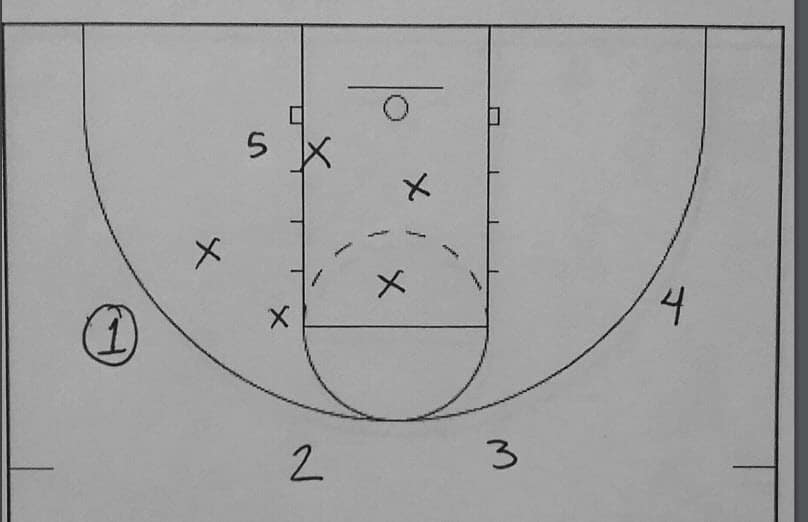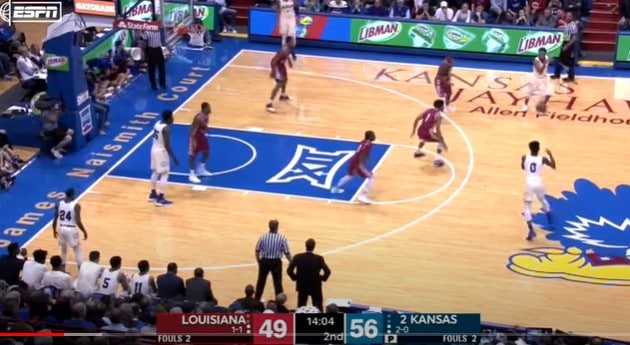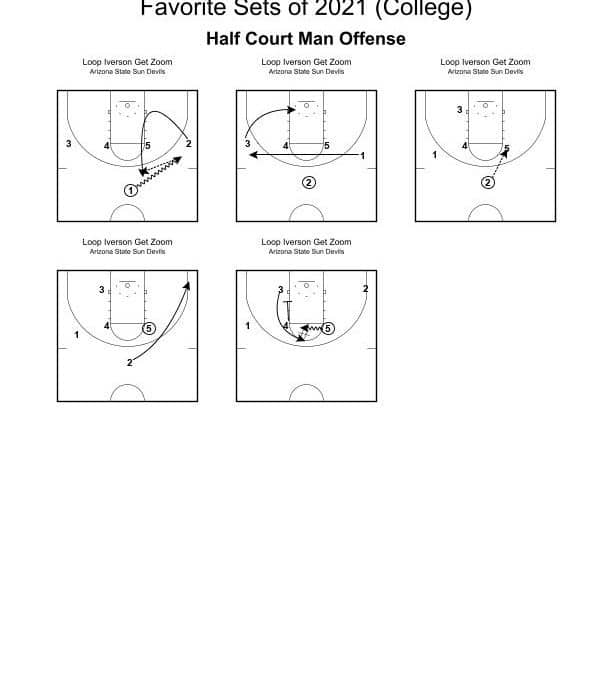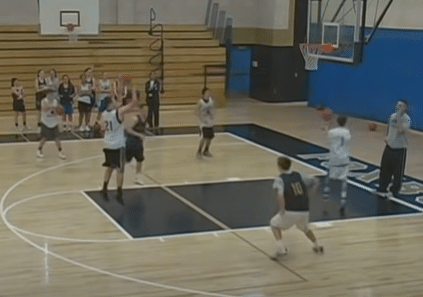Proper Spacing and Floor Balance in any Offense by Mike Cyprien, Jr
In a recent article on the principles of the “Motion” offense, I spoke about the offense operating efficiently using proper spacing and floor balance. Here I’ve decided to expand on the idea of the spacing and floor balance. With the use of visual diagramming, I’ll provide examples and ideas on the ways floor balance and spacing can aid in the improvement and efficiency of offense.
Different coaches at all levels of basketball may have their own individual idea of spacing. These ideas may vary, depending on the system, personnel, or the offensive philosophy. Ultimately, helping players gain an understanding will help, regardless of the situation.
Location in Relation to the Ball
The biggest problem players encounter when understanding playing with proper floor spacing is the location in relation to the ball or where the action is taking place. Players must have a thorough understanding of when to move towards and stay away from the basketball.
In “Diagram #1” we have the typical “4 out- 1 in” shell look with their defenders in help positions:
- Player 1 has possession of the ball above the 3 point line, free throw line extended.
- Players 2-4 are spaced about 10-12 feet away from one another
- Player 5, typically a post player, is on the strong side block. This player is about 10-12 feet away from the nearest offense player.
- All five players on the court show pretty good spacing. Each offensive player can see his/her defender and the other defenders in their help positions.

The distance in between players in Diagram 1 provides each player with a good view of the floor. Each player knows where the ball is located and can easily see each help defenders’ position. Because of this, each player can play off of one another; which way to move the ball, who to screen for, where to relocate to when the ball is moved, where the nearest driving gap is.
In Diagram #2 we’ll show the ball being driven towards the baseline and possible relocations of the offensive players in relation to the ball.
- As Player 1 drives the ball baseline towards the basket, players all relocate. This puts them in position to score or receive a pass to keep the ball moving.
- Players 2-5 may relocate in order to get in the ball handler’s view for a pass and/or put themselves in better scoring position.
- Players 2 and 3 relocate or rotate towards the ball. This gives the ball handler an outlet in the event the ball handler needs help or to reverse the ball. This is commonly called “dribble follow”.
- Player 4 relocates to the opposite corner. This is typically called a “drift” to the corner. Most teams teach the players opposite the ball to relocate or “drift” to the corner on his side of the floor, as it puts him/her in direct view of a player involved in a baseline drive.
- Player 5 may “shape up” or relocate towards the free throw line for spacing or to put himself in scoring position.
Diagram #3 shows the relocations of the other players if the ball is driven towards the middle of the court.
- Players 2 and 3 will space AWAY from the ball as it is driven in their direction. Because of the spacing action, defenders are forced to decide how long to stay and help on the drive which risks an open shot. Players who can really shoot it are a constant threat when the ball is driven towards them and really keep the defense off balance.
- Player 4 will slide towards the corner. This provides another opportunity for a penetrate and pitch scenario and put him/her in the sights of the ball handler.
- Player 5 may space to the short corner along the baseline.
I believe those players who know when and where to go in relation to the basketball tend to operate efficiently in motion type offenses. These players also understand their roles within the offense.
Moving Without The Ball
Offenses which are stagnant or ineffective usually struggle because players may not move well without the ball. Players often make the mistake of thinking they can only be effective when they have the ball in their possession. This isn’t always true. Some of the better scorers move well without the ball. These players do a good job of playing off of teammates and using them to get a good shot, reading their defender’s location, using screens correctly, and knowing when to cut. Players who move well without the ball rarely run towards the ball for they understand that will lead to bad floor spacing. For example, a player who’s a legit threat to score the ball or is a pretty good shooter from the perimeter may stay away from the ball. This “stretches” the defense or forces his/her defender to take a step or two out of help position because of the shooting threat. The ball typically finds these players, as their teammates know that they’re a threat to make shots so they’re more apt to swing the ball in their direction. Having the correct amount of spacing on the court not only improves the efficiency and flow of the offense but it also can keep the defense off balance. Good offenses have good player movement. They cut hard, screen well, and move the ball at a good pace. All of these elements keep the defense busy and forces them to defend multiple actions. Too much standing around on offense gives the defense a chance to rest and, most importantly, allows them to settle into help positions which makes it hard to score.
Keeping the Floor Balanced
Proper floor balance and spacing go hand in hand, in any offensive system. You can’t have one without the other. In dealing with motion offenses, most programs go with two types of systems; a “4-Out 1-In” look which is basically four players evenly spaced around the perimeter and a lone post player on either block, illustrated in Diagram #4; and a “3-Out 2-In” look which places three players on the perimeter (one player on each wing and a player at the top of the key) and a post player on each block, illustrated in Diagram #5.
Both 4-Out 1-In and 3-Out 2-In offenses are installed to help provide proper spacing and balance. Players in these offenses are given spots on the floor to fill or occupy. Once players become familiar and comfortable within the framework of these offenses, the spacing and balance will be consistent. The key is to make sure each spot is filled. Post players in both offenses know to keep the block positions occupied and perimeter players know to fill their spots as well.
Teaching Spacing and Floor Balance
In an attempt to help players gain an understanding of proper floor balance here are a few suggestions that may help;
- 2 on 0 drills. These drills involve players in pairs of two. A player in the top guard spot and another on the wing, above the three point line, free throw line extended. Using just one side of the court, basically cutting the court in half, this gives players a better understanding of spacing. They also learn how to set and receive screens, communicate with one another, and play off of one another. With only two players, they can get a clear understanding of how to play in and maintain proper spacing and keep the floor balanced. Penetrate-and-pitch, setting and receiving different screens, dribble handoffs, backdoor passes are great types of scenarios to practice.
- Once players get comfortable with 2 on 0 drills, you can add dummy defenders. Adding defenders allows players to learn how to read their defender’s position. They learn how to read driving gaps, space if the ball is driven their way, set their defender up to receive a screen, and locate a defender to set a screen.
- On-court markers. Using non-slip rubber dots or painters tape, coaches can put markers on the court as guides to help players remember areas on the court which need to be filled. This is used by coaches at every level of basketball, even the NBA.
Follow Coach Mike Cyprien, Jr on Twitter!!!
Click on the pdf link to download the Proper Spacing and Floor Balance in any Offense:




0 Comments